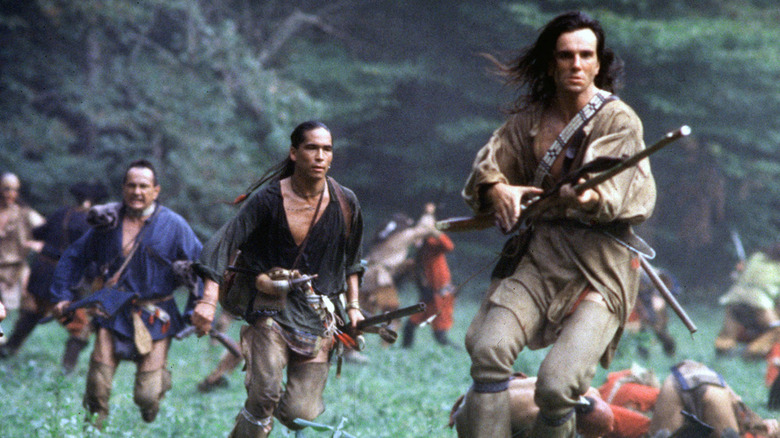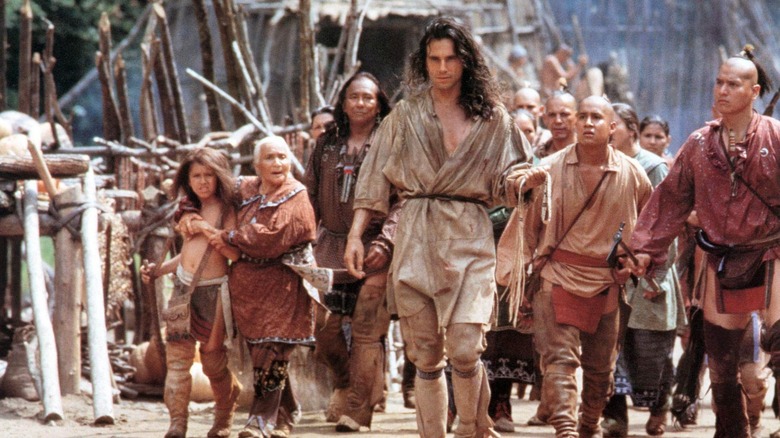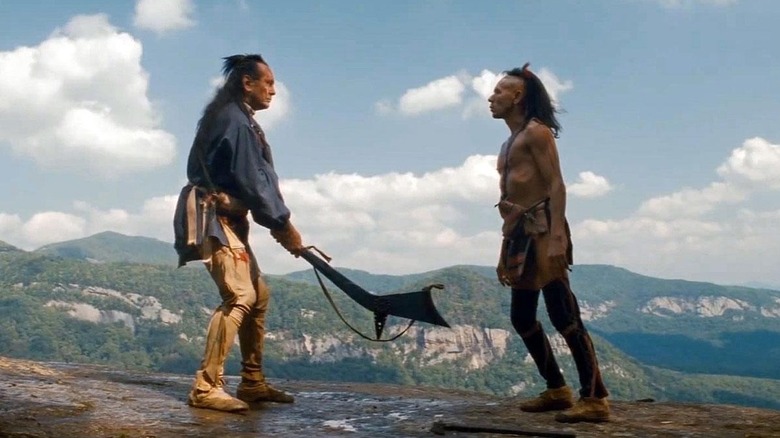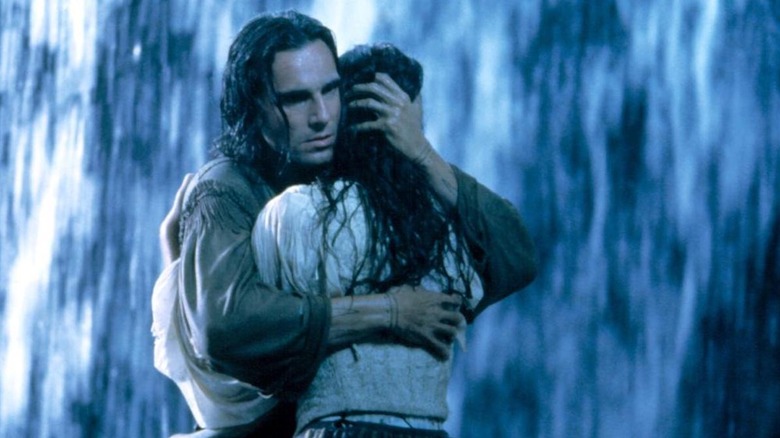The Last Of The Mohicans Took Its Toll On Daniel Day-Lewis' Mental Health
Some say getting away from it all is a great way to recover from stress, and no one does it quite like Daniel Day-Lewis. For his next film role after his very public breakdown on stage during a performance of "Hamlet," the famously intense actor took himself off to the wilderness to prepare for "The Last of the Mohicans."
Day-Lewis is well known for his commitment to method acting. Prior to taking on the role of Nathaniel "Hawkeye" Poe in Michael Mann's dashing adaptation of James Fenimore Cooper's historical yarn, he had stayed in character to portray Christy Brown in "My Left Foot." Brown was born with cerebral palsy, so Day-Lewis refused to leave his wheelchair during the shoot, resulting in crew members carrying him over lighting cables on set and feeding him at meal times. The hard work paid off with his first Oscar triumph.
For the part of Hawkeye, Day-Lewis underwent a strict training regime to build up his physique and stamina before heading to the woods of North Carolina to immerse himself in the survivalist lifestyle (via New York Times):
"Day-Lewis learned to track and skin animals, build canoes, fight with tomahawks, fire and reload a 12-pound flintlock on the run. The gun, because it never would have left the side of a hunter in the wild, went everywhere with Day-Lewis, including Christmas dinner."
As always, Day-Lewis' passion for losing himself in a character paid dividends for the finished film, but once again, it took a toll on his mental health.
So what happens in The Last of the Mohicans again?
It is 1757, and the British and French are battling for control of the American colonies. The British are putting pressure on local settlers to leave their families at the mercy of marauding Huron war parties to form a militia and lend reinforcements to the heavily outgunned Fort William Henry by Lake George, NY.
Stuffed shirt British Major Heyward (Steven Waddington) arrives and is given the task of escorting his would-be fiancee, Cora (Madeleine Stowe) and her sister Alice (Jodhi May) to their father, Colonel Munro (Maurice Roeves), who is in command of the besieged fort. He is assigned a unit of soldiers and a guide, Magua (Wes Studi), a vengeful Huron chief working for the French who is posing as a friendly Mohawk.
Magua leads the party into an ambush where most of Heyward's men are killed. Luckily, Nathaniel "Hawkeye" Poe (Day-Lewis) is hunting nearby with his adopted father, Chingachgook (Russell Means) and brother Uncas (Eric Schweig), and comes to the rescue. They agree to help Heyward escort the two women to the relative safety of the fort.
During their travels, Hawkeye and Cora fall for each other, which doesn't go down well with Heyward. Reaching the fort, Colonel Munro is initially grateful for saving his daughters' lives, but then charges Hawkeye with sedition for helping militia men escape to protect their families. Before the sentence can be carried out, Munro is forced to surrender the fort to the French commander, who guarantees their safety. The treacherous Magua has other ideas...
How well does The Last of the Mohicans hold up?
In his review for "A Time to Kill," Roger Ebert wrote that "the movie is interested in white people as characters and the black characters... as atmosphere." Despite the efforts of Day-Lewis, Michael Mann, and his production crew to make the film as authentic as possible, there is an element of this in "The Last of the Mohicans." The Native-American actors, especially Means, Studi, and Schweig, all cut impressive figures, but it is still very much a film about white people's problems set against a historical backdrop where the natives' allegiances were torn between two colonizing forces. There is an attempt to build a second romance for Uncas and Alice, but that feels very underfed compared to the instant magnetism between Hawkeye, an English orphan raised by a Mohican family, and Cora, an upper-crust English woman.
As a historical romantic adventure, "The Last of the Mohicans" is hard to beat. The cinematography is lush and the score is simply irresistible. My mum absolutely loves this movie, but I only ever saw bits of it until recently. I just didn't fancy it before, but now I understand. It's a gloriously old-fashioned swashbuckler, which Mann (who co-wrote the screenplay) based on the 1936 Randolph Scott adaptation rather than Cooper's novel, adding the romance element that didn't exist in the book. It takes a while to get fully going, but once you reach that epic finale at the waterfall it's hard not to swoon at its passion and sweep.
Daniel Day-Lewis gives it his all once again
Daniel Day-Lewis's performance as Hawkeye is fairly low-key compared to later grandstanding roles like Bill the Butcher in "Gangs of New York" and Daniel Plainview in "There Will Be Blood," but his commitment to authenticity earned the respect of Russell Means, the Native American activist who plays Chingachgook in the movie (via New York Times). Means said that Day-Lewis is "one of the most considerable human beings I ever met... Daniel is the embodiment of someone I would adopt as a non-Indian."
Day-Lewis's hard work really shows in the gripping finale, charging full tilt across a rocky precipice, unloading a rifle into an enemy on the run and, without breaking stride, dropping it and picking up his vanquished foe's weapon in its place. It's a lean and muscular performance where Hawkeye's actions and silent reactions speak louder than his words. Which, coming from the lips of an actor of Day-Lewis's caliber, sure pack a punch as well. Once again, Day-Lewis stayed in character during the shoot:
"He didn't seem to allow himself anachronisms. Between scenes a few of the Mohicans shared a Marlboro, stubbing it out with their moccasins; Hawkeye rolled his own cigarettes. While redcoats in reflective sunglasses would strap on their Walkmans or touch up their beards with electric razors, Day-Lewis tended to go off by himself and sit under a tree in the sun."
It was a tough shoot, and Day-Lewis reportedly suffered claustrophobia and slight hallucinations afterwards, having once again put his mental well-being on the line and proving himself one of the hardest working modern-day actors.



